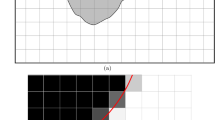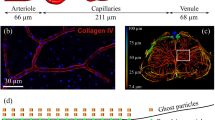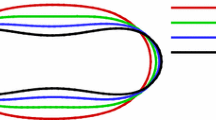Abstract
Particle-based methods such as smoothed particle hydrodynamics and dissipative particle dynamics are apt for simulating particle-like suspensions in blood. The blood flow through the microvasculature and its dynamics is strongly influenced by the dominant suspensions, and the red blood cells (RBCs) in plasma. The deformation dynamics of RBCs flowing through capillaries is of practical importance to be able to exploit the understanding for device development. In the present study, dynamics of a pair of RBCs flowing through a symmetric and an asymmetric bifurcating microfluidic channel are simulated. The finite-sized dissipative particle dynamics framework in conjunction with a discrete model for the RBCs is employed to model the system. When the RBCs flow through a bifurcating channel, the cell shape, deformability and flow rate ratios through the daughter branches are investigated. The deformed shape of RBC at the bifurcating channel’s tip was found to compare well with experimental observations. It was found that for flow through an asymmetric bifurcating channel, RBC near the separating streamline passed through the low flow rate branch, although lateral migration was observed. The trade-off effects and following effects of the two RBCs were particularly noticed in symmetric bifurcation. In the case of RBCs moving as a pair, it was found that the cell–cell interactions influence the path selection of RBCs as it approaches the tip of bifurcation. Specifically, RBC motion towards the low flow rate branch was observed.











Similar content being viewed by others
References
Fung YC (1973) Stochastic flow in capillary blood vessels. Microvasc Res 5(1):34. https://doi.org/10.1016/S0026-2862(73)80005-6
Yoganathan A, Chandran K, Rittgers S (2012) Rheology of blood and vascular mechanics. Taylor and Francis Group, London. https://doi.org/10.1201/b11709
Pries AR, Ley K, Claassen M, Gaehtgens P (1989) Red cell distribution at microvascular bifurcations. Microvasc Res 38(1):81
Enden G (1994) A numerical study of plasma skimming in small vascular bifurcations. Trans ASME J Biomech Eng 116(1):79
El-Kareh AW, Secomb TW (2000) A model for red blood cell motion in bifurcating microvessels. Int J Multiph Flow 26(9):1545
Pries AR, Secomb TW, Gaehtgens P, Gross JF (1990) Blood flow in microvascular networks. In: Circulation research, pp 3–36
Gijsen FJH, van de Vosse FN, Janssen JD (1999) The influence of the non-Newtonian properties of blood on the flow in large arteries: steady flow in a carotid bifurcation model. J Biomech 32(6):601
Inoue Y, Takagi S, Matsumoto Y (2006) A mesoscopic simulation study of distributions of droplets in a bifurcating channel. Comput Fluids 35(8–9):971. https://doi.org/10.1016/j.compfluid.2005.07.018
Sun C, Munn LL (2008) Lattice-Boltzmann simulation of blood flow in digitized vessel networks. Comput Math Appl 55(7):1594
Jafari A, Mousavi SM, Kolari P (2008) Numerical investigation of blood flow. Part I: in microvessel bifurcations. Commun Nonlinear Sci Numer Simul 13(8):1615
Barber JO, Alberding JP, Restrepo JM, Secomb TW (2008) Simulated two-dimensional red blood cell motion, deformation, and partitioning in microvessel bifurcations. Ann Biomed Eng 36(10):1690. https://doi.org/10.1007/s10439-008-9546-4
Li X, Popel AS, Karniadakis GE (2012) Bloodplasma separation in Y-shaped bifurcating microfluidic channels: a dissipative particle dynamics simulation study. Phys Biol 9(2):026010. https://doi.org/10.1088/1478-3975/9/2/026010
Hyakutake T, Nagai S (2015) Numerical simulation of red blood cell distributions in three-dimensional microvascular bifurcations. Microvasc Res 97:115. https://doi.org/10.1016/j.mvr.2014.10.001
Xiong W, Zhang J (2012) Two-dimensional lattice Boltzmann study of red blood cell motion through microvascular bifurcation: cell deformability and suspending viscosity effects. Biomech Model Mechanobiol 11(3–4):575. https://doi.org/10.1007/s10237-011-0334-y
Chesnutt JK, Marshall JS (2009) Effect of particle collisions and aggregation on red blood cell passage through a bifurcation. Microvasc Res 78(3):301. https://doi.org/10.1016/j.mvr.2009.09.003
Barber JO, Restrepo JM, Secomb TW (2011) Simulated red blood cell motion in microvessel bifurcations: effects of cell–cell interactions on cell partitioning. Cardiovasc Eng Technol 2(4):349. https://doi.org/10.1007/s13239-011-0064-4
Yin X, Thomas T, Zhang J (2013) Multiple red blood cell flows through microvascular bifurcations: cell free layer, cell trajectory, and hematocrit separation. Microvasc Res 89:47. https://doi.org/10.1016/j.mvr.2013.05.002
Wang T, Rongin U, Xing Z (2016) A micro-scale simulation of red blood cell passage through symmetric and asymmetric bifurcated vessels. Sci Rep 6(1):1. https://doi.org/10.1038/srep20262
Tripathi S, Varun Kumar YV, Prabhakar A, Joshi SS, Agrawal A (2015) Passive blood plasma separation at the microscale: a review of design principles and microdevices. J Micromech Microeng 25(8):083001. https://doi.org/10.1088/0960-1317/25/8/083001
Enden G, Popel AS (1992) A numerical study of the shape of the surface separating flow into branches in microvascular bifurcations. J Biomech Eng 114(3):398. https://doi.org/10.1115/1.2891401
Peng Z, Chen YL, Lu H, Pan Z, Chang HC (2015) Mesoscale simulations of two model systems in biophysics: from red blood cells to DNAs. Comput Part Mech 2(4):339. https://doi.org/10.1007/s40571-015-0057-4
Anand DV, Vedantam S, Patnaik BSV (2016) Dissipative particle dynamics simulation of shear flow in a microchannel with a deformable membrane. Microfluid Nanofluid 20(12):1–13
Vijay Anand D, Patnaik BSV, Vedantam S (2017) A dissipative particle dynamics study of a flexible filament in confined shear flow. Soft Matter 13(7):1472
Hassanzadeh A, Pourmahmoud N, Dadvand A (2017) Numerical simulation of motion and deformation of healthy and sick red blood cell through a constricted vessel using hybrid lattice Boltzmann-immersed boundary method. Comput Methods Biomech Biomed Eng 20(7):737. https://doi.org/10.1080/10255842.2017.1298746
Ju M, Ye SS, Namgung B, Cho S, Low HT, Leo HL, Kim S (2015) A review of numerical methods for red blood cell flow simulation. Comput Methods Biomech Biomed Eng 18(2):130
Oulaid O, Saad AKW, Aires PS, Zhang J (2016) Effects of shear rate and suspending viscosity on deformation and frequency of red blood cells tank-treading in shear flows. Comput Methods Biomech Biomed Eng 19(6):648. https://doi.org/10.1080/10255842.2015.1055734
Pan W, Caswell B, Karniadakis GE (2010) A low-dimensional model for the red blood cell. Soft Matter 6(18):4366. https://doi.org/10.1039/c0sm00183j
Balachandran Nair AN, Pirker S, Umundum T, Saeedipour M (2020) A reduced-order model for deformable particles with application in bio-microfluidics. Comput Part Mech 7(3):593. https://doi.org/10.1007/s40571-019-00283-8
Ye T, Phan-Thien N, Lim CT (2016) Particle-based simulations of red blood cells. A review. J Biomech 49(11):2255. https://doi.org/10.1016/j.jbiomech.2015.11.050
Yazdani A, Deng M, Caswell B, Karniadakis GE (2016) Flow in complex domains simulated by dissipative particle dynamics driven by geometry-specific body-forces. J Comput Phys 305:906. https://doi.org/10.1016/j.jcp.2015.11.001
Alizadehrad D, Fedosov DA (2018) Static and dynamic properties of smoothed dissipative particle dynamics. J Comput Phys 356:303. https://doi.org/10.1016/j.jcp.2017.12.009
Gao C, Zhang P, Marom G, Deng Y, Bluestein D (2017) Reducing the effects of compressibility in DPD-based blood flow simulations through severe stenotic microchannels. J Comput Phys 335:812. https://doi.org/10.1016/j.jcp.2017.01.062
Ghorbani N, Pishevar A (2018) A mesoscopic simulation of static and dynamic wetting using many-body dissipative particle dynamics. Comput Part Mech 5(1):113. https://doi.org/10.1007/s40571-017-0157-4
Ranjith SK, Patnaik BSV, Vedantam S (2013) No-slip boundary condition in finite-size dissipative particle dynamics. J Comput Phys 232(1):174. https://doi.org/10.1016/j.jcp.2012.07.046
Fan X, Phan-Thien N, Chen S, Wu X, Ng TY (2006) Simulating flow of DNA suspension using dissipative particle dynamics. Phys Fluids 18(6):063102. https://doi.org/10.1063/1.2206595
Pan W, Pivkin IV, Karniadakis GE (2008) Single-particle hydrodynamics in DPD: a new formulation. EPL 84(1):10012
Hoque SZ, Anand DV, Patnaik BSV (2018) The dynamics of a healthy and infected red blood cell in flow through constricted channels: a DPD simulation. Int J Numer Methods Biomed Eng 34(9):3105. https://doi.org/10.1002/cnm.3105
Willemsen SM, Hoefsloot HCJ, Iedema PD (2000) No-slip boundary condition in dissipative particle dynamics. Int J Mod Phys C 11(05):881. https://doi.org/10.1142/S0129183100000778
Pivkin IV, Karniadakis GE (2005) A new method to impose no-slip boundary conditions in dissipative particle dynamics. J Comput Phys 207(1):114. https://doi.org/10.1016/j.jcp.2005.01.006
Fedosov DA, Pivkin IV, Karniadakis GE (2008) Velocity limit in DPD simulations of wall-bounded flows. J Comput Phys 227(4):2540
Pivkin IV, Karniadakis GE (2006) Controlling density fluctuations in wall-bounded dissipative particle dynamics systems. Phys Rev Lett 96:206001. https://doi.org/10.1103/PhysRevLett.96.206001
Abu-Nada E, Kumar A, Asako Y, Faghri M (2012) Dissipative particle dynamics for complex geometries using non-orthogonal transformation. Int J Numer Methods Fluids 68(3):324. https://doi.org/10.1002/fld.2508
Kasiteropoulou D, Karakasidis T, Liakopoulos A (2013) Mesoscopic simulation of fluid flow in periodically grooved microchannels. Comput Fluids 74:91
Zhang D, Shangguan Q, Wang Y (2018) An easy-to-use boundary condition in dissipative particle dynamics system. Comput Fluids 166:117
Groot R, Warren P (1997) Dissipative particle dynamics: bridging the gap between atomisticand mesoscopic simulation. J Chem Phys 107(11):4423
Dzwinel W, Yuen DA (2000) Matching macroscopic properties of binary fluids to the interactions of dissipative particle dynamics. Int J Mod Phys C 11(01):1. https://doi.org/10.1142/S012918310000002X
Trofimov S (2003) Thermodynamic consistency in dissipative particle dynamics. Technische Universiteit Eindhoven, Eindhoven. https://doi.org/10.6100/IR570813
Ranjith SK, Vedantam S, Patnaik BSV (2015) Hydrodynamics of flow through microchannels with hydrophobic strips. Microfluid Nanofluid 19(3):547
Pries AR, Secomb TW (2011) Blood flow in microvascular networks. Wiley, Hoboken. https://doi.org/10.1002/cphy.cp020401
Author information
Authors and Affiliations
Corresponding author
Ethics declarations
Conflict of interest
Authors declare that they have no known competing financial interests or personal relationships that could have appeared to influence the work reported in this manuscript.
Additional information
Publisher's Note
Springer Nature remains neutral with regard to jurisdictional claims in published maps and institutional affiliations.
Rights and permissions
About this article
Cite this article
Hoque, S.Z., Anand, D.V. & Patnaik, B.S.V. A dissipative particle dynamics simulation of a pair of red blood cells in flow through a symmetric and an asymmetric bifurcated microchannel. Comp. Part. Mech. 9, 1219–1231 (2022). https://doi.org/10.1007/s40571-021-00453-7
Received:
Revised:
Accepted:
Published:
Issue Date:
DOI: https://doi.org/10.1007/s40571-021-00453-7




